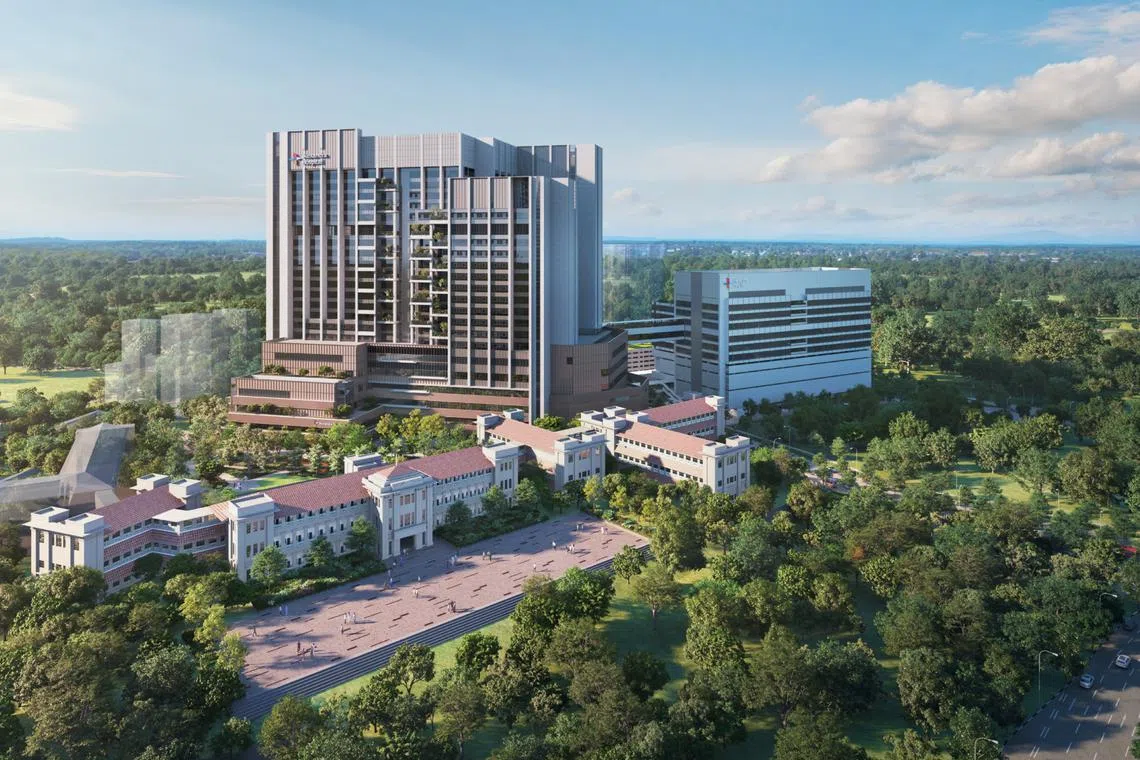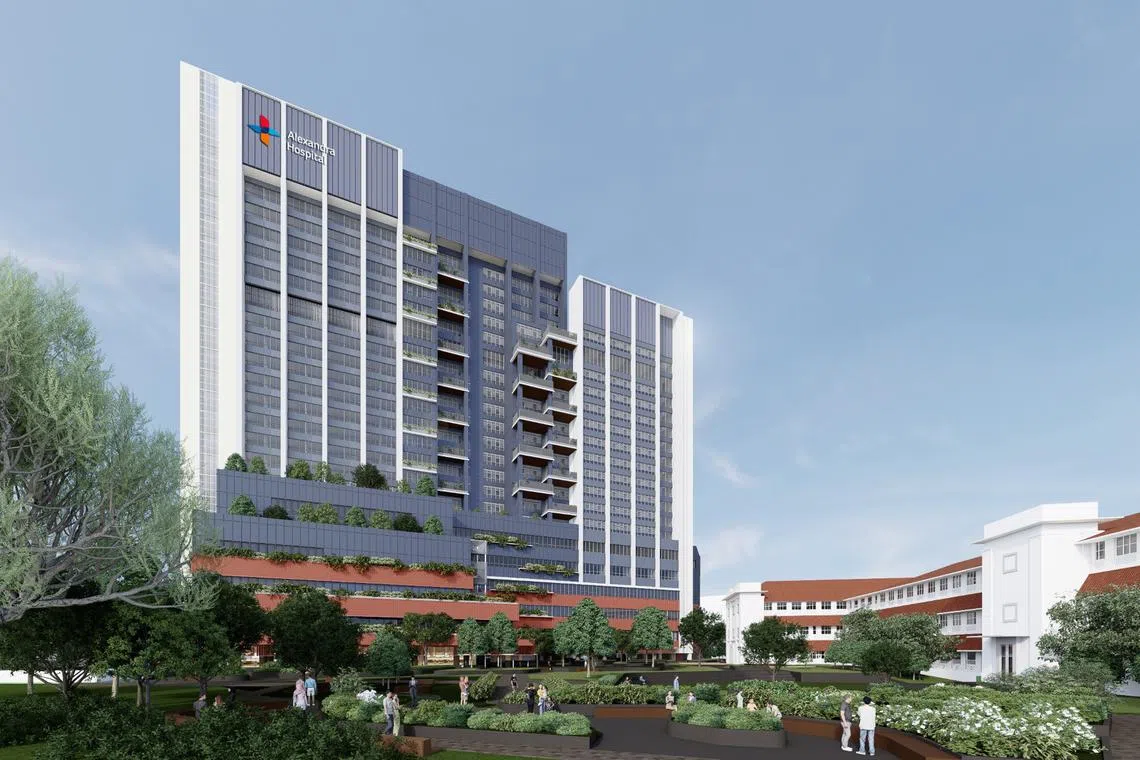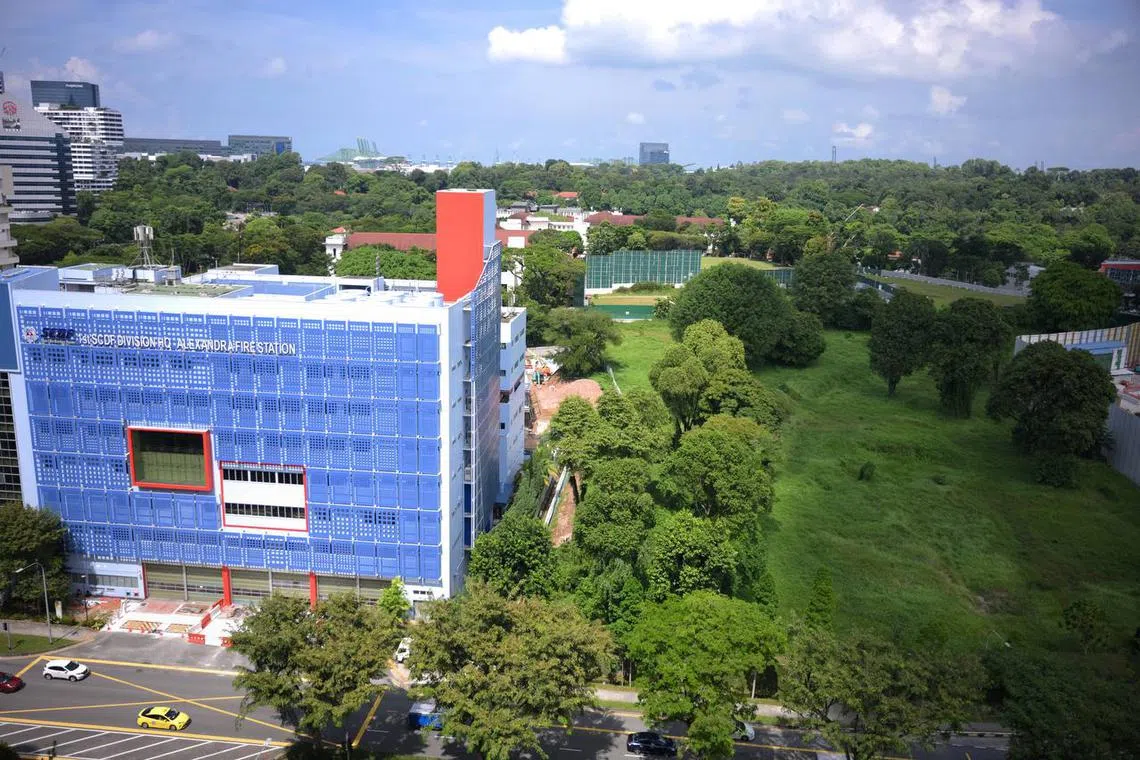Redeveloped Alexandra Hospital to house emergency department, around 1,300 beds
Sign up now: Get ST's newsletters delivered to your inbox

The 1,300 beds at the redeveloped Alexandra Hospital will include beds for patients undergoing hospice care and psychiatric care.
PHOTO: ALEXANDRA HOSPITAL
Follow topic:
SINGAPORE – From 2028, the 300-bed Alexandra Hospital in Queenstown will be transformed into a bigger hospital comprising about 1,300 beds in total, with the addition of two new high-rise buildings among other upgrades.
The National University Hospital (NUH) campus will also be redeveloped over more than 10 years, starting from 2025, Health Minister Ong Ye Kung announced on May 15 at the ground-breaking ceremony for Alexandra Hospital’s (AH) redevelopment.
These are part of the Government’s plans to increase hospital capacity to meet rising needs. In April, construction work began for the Eastern General Hospital in Bedok North, which will have 1,400 beds.
AH was built by the British in 1938 as the British Military Hospital Singapore. Its redevelopment includes a new pandemic-ready emergency department that is directly connected to the intensive care unit and operating theatre.
Public ambulances will be able to ferry patients living in the vicinity to its emergency department. Currently, AH has a 24-hour urgent care centre, rather than an emergency department.
The 1,300 beds at the redeveloped AH will include beds for patients in hospice and psychiatric care. AH did not provide details on how tall the two new high-rise buildings will be.
A nursing home with about 400 beds will also be built on the same campus, located in a separate building from the two high-rise ones.
This is so that AH can better serve residents in Queenstown, which is home to one of Singapore’s oldest populations, with around one in four residents aged 65 and above.
Throughout its redevelopment, the hospital will continue to operate as usual.

Health Minister Ong Ye Kung at the groundbreaking ceremony for Alexandra Hospital’s (AH) redevelopment on May 15.
ST PHOTO: MARK CHEONG
AH is part of the National University Health System (NUHS) cluster, one of three public healthcare clusters in Singapore.
In this cluster, the 1,200-bed NUH serves as the western region’s main emergency and trauma care hospital.

Alexandra Hospital is part of the National University Health System (NUHS) cluster, one of three public healthcare clusters in Singapore.
PHOTO: ALEXANDRA HOSPITAL
Mr Ong said its buildings are 40 to 50 years old, and to ensure that the hospital can meet evolving healthcare needs, a redevelopment of the entire NUH campus is in the works. This will likely add more to the hospital capacity, intensify land use and also improve the existing road network, he added.
The redevelopment of the NUH campus is scheduled to commence in 2025 and expected to take well over a decade, he said.

At the ground-breaking ceremony, AH’s chief executive, Associate Professor Jason Phua, said one thing different about AH is its care model, which aims to make complex healthcare simpler for patients by offering patients acute care and rehabilitative care by the same care team in the same location.
This means the care will vary to match the patient, so that the patient does not have to transfer across medical teams, wards or hospitals, Prof Phua said.
Patients are assigned one of three levels of acuity of care based on their clinical conditions, and are managed by one group of doctors, nurses, pharmacists and allied health professionals throughout their stay.

The vacant area (right) next to Alexandra Fire Station which will be part of Alexandra Hospital’s redevelopment.
ST PHOTO: MARK CHEONG
From 2018, when it started practising this model of care, to 2023, about 25 per cent of patients who were initially admitted for acute care (the highest two levels of acuity), transited to rehabilitative care (the lowest level), all while staying in the same bed and being managed by the same care team, according to data provided by AH.
Mr Ong said that AH has found that this model – which he calls a bold experiment – can shorten the length of stay for patients who require both acute and community hospital care, and will implement it at scale when the redevelopment is completed.
With outpatient care at AH also consolidated under one doctor, patients see just one principal doctor, instead of several specialists. Prof Phua said this is possible because the principal doctor is supported behind the scenes by a group of doctors from multiple specialities who work together and consult each other when necessary.
Today, more than 90 per cent of AH’s patients discharged from its wards see not more than one doctor for outpatient care, he said.
Another thing that AH aims to do is to involve family members and loved ones of patients more in bedside care. To facilitate this, it is ramping up support for caregivers. For instance, the new wards will come with spaces for caregivers to rest and stay overnight.

The redeveloped Alexandra Hospital’s inpatient and outpatient towers will be connected at various levels by bridges, and movements between the hospital buildings and the nursing home will be seamless.
PHOTO: ALEXANDRA HOSPITAL
On May 15, AH also said it plans to extend its tele-triaging service to JurongHealth Campus and National University Hospital, National University Polyclinics, general practitioners, primary care providers and community partners.
In 2020, it had set up a Virtual Care Centre to provide a helpline to discharged patients and doctors in the community, in order to minimise the need for emergency visits and hospital admissions.
With the redevelopment, AH will be connected to adjacent residential areas and the adjoining Rail Corridor. Its inpatient and outpatient towers will be connected at various levels by bridges, and movements between the hospital buildings and the nursing home will be seamless.
AH plans to open the new facilities progressively from 2028.


